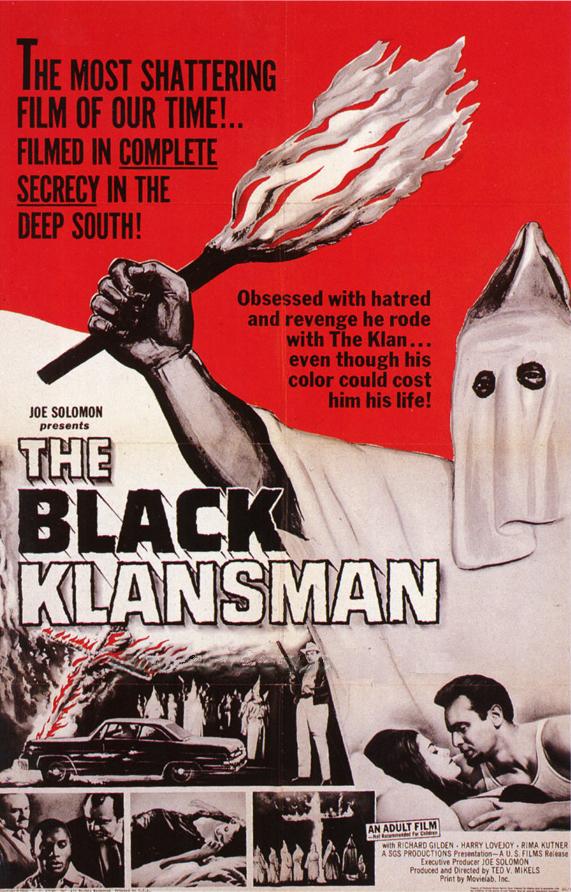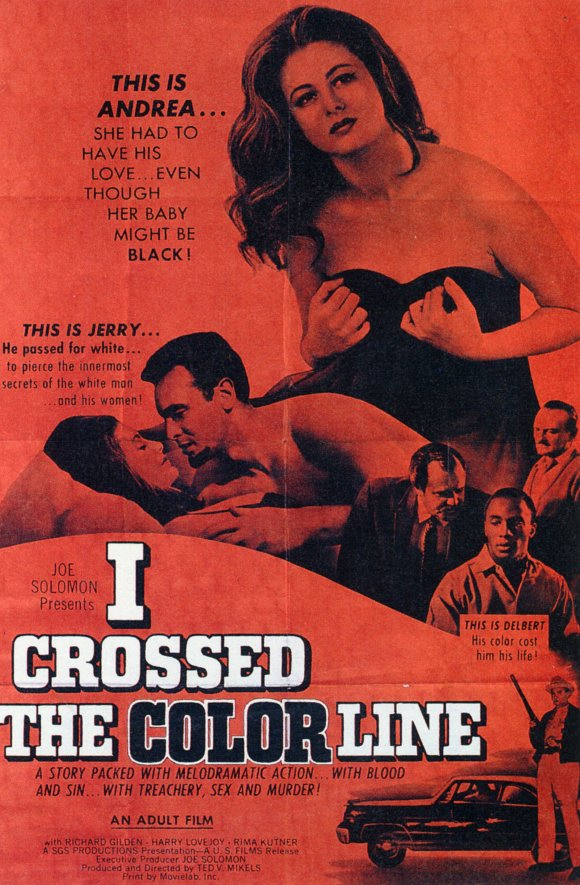
[THE CHALK-OUTLINE]
The Black Klansman a.k.a. I Crossed The Color Line (1966): Breakdown by Kain424
A black man’s daughter is killed in a Ku Klux Klan attack. He disguises himself as a white man and infiltrates the Klan in order to bring down the man responsible. Goofiness ensues.
[THE EXECUTION]
While the Blaxploitation genre is generally agreed to have been kicked off in 1971 with Sweet Sweetback’s Baadasssss Song and Shaft, many of the themes and elements found therein were seen in a few films of the previous decade. Of note, is The Black Klansman. The movie sets a lot of the groundwork for the coming genre, with the overt focus on ethnic sexuality, female submission, and racial injustice.

And yet the whole thing comes off less cool, and more like schlock. This isn’t a surprise when you realize the director, Ted Mikels, was and still is, a professional schlock director. The Black Klansman is ultimately meant to shock white audiences by playing off their fears and sympathies. The blacks in this are truly terrorized by The Klan, and violently so. Using squibs and primitive gore effects, the movie does manage to shock a bit, even in this day and age. And though effects would begin producing better results a couple years later in Night Of The Living Dead, one simply never saw this sort of thing in movies. I can only imaging what it was like for audiences at the time.

The Action is all very slow and boring, but the emphasis seems to be on realism. There is no stylization to pistol-whipping a guy in the back of the head. In fact, while there are fights, shootings, and even attempts at vehicular homicide, the focus is less on what’s happening than on the issues surrounding the movie. The intent here is to provoke a strong emotional reaction from the viewer due to the violence and the situations.

Still, many of the “shock” moments fall flat. This is mostly due to the film becoming dated and the movie now stands as a testament to effectiveness of the Civil Rights movement. Seeing the black protagonist in a bed or in a car, kissing a white woman, no longer has the jolting effect I’m sure it had in the mid-60s. Also, the casting of Richard Gilden, while it sort of works for the story, was a bit of a mistake. He’s simply too light-skinned to be believable as a black man. But more on that later.
Interestingly, the movie isn’t simply black and white (seriously, no pun intended). At times, several KKK members seem remorseful for their actions and a violent black group attempts to meet violence with violence, confusing the issue of revenge and its justifications. While it ends up being largely a very dated sleaze film, the movie remains impressively aware of the political problems it’s facing in the script.
Missing the funk music styles and overcompetent hero, The Black Klansman doesn’t quite make it as a clear example of blaxploitation. But it’s still an interesting watch. It’s got guns, babes, violent blacks versus the KKK, and intense sequences of human destruction. If you get a chance to see it, don’t pass it up.
[HOW BAD-ASS IS THE MAIN CHARACTER?]

Richard Gilden is Jerry Ellsworth
Apparently a musician who left his black wife and kid behind him when he went to California, Jerry Ellsworth seems like a deadbeat to me. He goes into a rage, however, upon learning his daughter was burned alive in a KKK church attack and manages a fairly complicated means of vengeance.

He takes on a few adversaries over the course of the film and even battles a guy in a pick-up truck. But is he really all that bad-ass? Nah, not really.
[THE BODY COUNT: 7]

The movie starts off with a violent scene in which a black man gets shot to death by a group of Klan members. From there we get a little girl burned to death, another shot just offscreen, a couple hanged, and yet another shot in the face. The violence is worthy of an R-rating nowadays, so I can only assume it was quite controversial at the time of its initial release.
[MOST SATISFYING DEATH]
The villain manages to gain the upper hand, and climbs into a pick-up truck. From there we are treated to a duel between our hero and the vehicle. After getting his shooting hand crushed beneath the wheels of the truck, Jerry begins firing blindly at the oncoming death machine with his other arm. The truck veers off and smashes into a tree.

Upon inspection, we see Jerry has blown out the back of the man’s skull. Pretty gnarly.
[DUDESWEAT AND MACHISMO]
Other than Jerry’s hideous underwear, there ain’t much to say here.
[EXPLOITATION AND MISOGYNY]
The girls can’t resist the dark meat. Or, in the case of this film, the very light-but-supposedly-actually-dark meat. Jerry shags one girl early on, and then seduces the Klan leader’s daughter. But despite what the alternate title poster would have you believe, none of these girls seem all that concerned about getting pregnant.

One odd (and tragic) thing I noticed though, was that Jerry’s girl Andrea still seeks reconciliation after he chokes her and slams her around in a fit of racial rage. He momentarily blames her and the whole white race for what happened to his daughter (that he left behind to become famous), and she completely forgives him. Way to go, 1966!
[EPIC MOMENT AND BEST ONE-LINER]
The epic moment for the film also contains my favorite one-liner. Unfortunately, I like it all for the wrong reasons. Gilden is playing a black man disguised as a white man, but even without his ridiculous wig he simply seems like a white dude with curly hair.

But on with it. The Klan have captured the members of a black militant group and Jerry’s friends. Jerry breaks everything up, but allows the Klan members to leave. All but the leader. Jerry explains to The Man that he’s destroyed the Klan rally and essentially ruined the guy’s life. But his victim wants to know why. And so Jerry reveals himself:
[flashvideo filename=videos/TBK.avi.FLV /]
This is supposed to be the big shocking moment of the film, but it only ends up being goofy as a result of Gilden’s over-apparent whiteness. Even the way he talks is white. What is especially great about the scene is how the villain just gawks at him and squints his eyes as if he’s waiting for someone to tell him it’s all a joke. Oh well, I got to laugh out loud so I can’t say I didn’t enjoy myself.
[THE MORAL OF THE STORY]
Black people should organize themselves and white people should be more tolerant.
[THE CHECKLIST: 10 outta 25]
[ ] Athlete(s) Turned “Actor”
[ ] Clinging To The Outside Of A Moving Vehicle
[ ] Crotch Attack
[ ] Dialogue Telling Us How Bad-Ass The Main Character(s) Is/Are
[ ] Ending Featuring An Ambulance, A Blanket or A Towel
[ ] Factory/Warehouse
[X] Giant Explosion(s)
[ ] Heavy Artillery
[ ] Improvised Weapon(s)
[ ] Macho Mode(s) Of Transportation
[X] Main Character Sports Facial Accessory(s) [a wig]
[ ] Manly Embrace(s)
[ ] Notorious Stunt-Man Sighting
[X] Passage(s) Of Time Via Montage
[X] Politically Fueled Plot Point(s)
[X] Senseless Destruction Of Property
[X] Shoot Out(s) and/or Sword Fight(s)
[ ] Slow-Motion Finishing Move(s)/Death(s)
[X] Stupid Authoritative Figure(s)
[X] Substance Usage and/or Abuse
[ ] Tis The Season
[X] Torture Sequence(s)
[ ] Unnecessary Sequel
[ ] Vehicle Chase(s)
[X] Vigilante Justice
